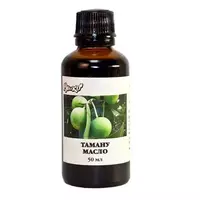Tamanu oil

The tamanu walnut tree or Alexandrian laurel Calophyllium Inophyllum is a large evergreen that can reach a height of 20 meters. The homeland of this species of laurel is considered to be the region of East Africa, as well as Australia and India. Currently, tamana is cultivated on an industrial scale in Sri Lanka, the Maldives, as well as in the Indian states of Tamil Nadu and Kerala.
It is worth noting that the Alexandrian laurel is considered a common ornamental plant that feels great in the tropical climatic belts of planet Earth. The Alexandrian laurel grows very slowly. It is worth noting that this plant is unpretentious and can grow on various types of soil. For thousands of years, residents of tamanu growing areas have been using the plant in various fields.
The wood of the plant goes to the construction and manufacture of furniture. Components of the plant are used for food, as well as as an effective means of traditional medicine. However, tamanu vegetable oil is of particular value, which, due to its distinctive properties, has found a wide range of applications in various branches of human activity.
In its appearance, tamanu oil does not differ from other varieties of bay oil. Tamanu oil may have a different color depending on the method of manufacturing the product, as well as the starting material. However, as a rule, the shade of tamanu oil is within the light or dark green color scheme. Tamanu oil is distinguished by its solid wax-like consistency.
Experts say that the aroma of tamana oil resembles a traditional Indian kari, in which nut notes are guessed. Tamanu oil is obtained from the core of inedible fruits of the tree. It is worth noting that the process of producing tamanu oil takes place in several main stages. Initially, the fruits of the plant are processed and separate the valuable core.
For several months, the core of the tamanu fruit is dried naturally in direct sunlight. During this period, the fruits of the plant lose more than half the mass and change color. Not only the appearance, but also the chemical composition of plant raw materials is modified. After drying, the core of tamanu fruits contains about 50% of the most valuable vegetable oil.
As a rule, tamana oil is produced by cold persistence. This method helps preserve most of the beneficial compounds that are found in tamanu vegetable oil. Tamanu oil is enriched with a significant amount of E vitamins, which differ in antioxidant properties. In addition, tamanu oil contains fatty acids that are indispensable for the human body.
Tamanu oil is used as an anti-inflammatory and antibacterial agent. Tamanu vegetable oil helps to heal serious wounds as well as burns. Tamanu oil enhances blood circulation. In medicine, tamanu oil is used in the treatment of skin diseases. In addition, tamanu oil contributes to the healing of insect bites. Usually, tamanu oil is used externally, but refined versions of the product can be used as a vitamin dressing for salads.
tamanu oils 884 kCal
Energy value of tamanu oil (Ratio of proteins, fats, carbohydrates - ju):
Proteins: 0 g (~ 0 kCal)
Fats: 100g (~ 900 kCal)
Carbohydrates: 0 g (~ 0 kCal)
Energy ratio (bj | y): 0% | 102% | 0%
 Español
Español Français
Français Português
Português Русский
Русский 简体中文
简体中文 繁體中文
繁體中文 日本語
日本語 한국어
한국어 العربية
العربية Türkçe
Türkçe Қазақ
Қазақ Deutsch
Deutsch Italiano
Italiano Українська
Українська
